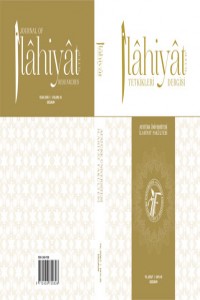Ortaokul Din Kültürü ve Ahlak Bilgisi Öğretmenlerinin Alternatif Ölçme ve Değerlendirme Tekniklerini Kullanma Düzeyleri ve Karşılaştıkları Sorunlar / Secondary School Religious Culture and Ethic Teachers’ Level of Using Alternative Techniques of Measureme
Abstract
Bu araştırmanın amacı ortaokullarda görev yapan DKAB öğretmenlerinin, AÖD tekniklerini
kullanma düzeylerini belirlemek, uygulamada karşılaşılan sorunları tespit etmek ve bu sorunlara
yönelik çözüm önerilerinde bulunmaktır.
Araştırmanın evrenini 2014–2015 eğitim öğretim yılında Sivas il merkezine bağlı ortaokullarda
görev yapan 147 Din Kültürü ve Ahlak Bilgisi öğretmeni oluşturmaktadır. Evreni oluşturan 147
öğretmenin tümüne ulaşılması hedeflenmiş, ancak 120’sine ulaşılabilmiştir. Buna göre hedef kitleye
ulaşma oranı % 81,63’tür. Ayrıca evren içerisinden rastgele seçilen 10 öğretmenle de görüşme yapılmıştır.
Öğretmenlere uygulanan anketten hem nicel hem de nitel veriler elde edilmiştir. Nicel verilerin
analizinde, yüzde ve frekans kullanılarak tablolar hazırlanmış, tabloların altında ise açıklamalar
yapılmıştır. Nitel verilerin analizinde ise betimsel analiz teknikleri kullanılmıştır.
Araştırma sonuçları değerlendirildiğinde performans, proje, gözlem ve kavram haritası tekniklerinin
kullanılma düzeylerinin diğer tekniklere göre daha yüksek olduğu görülmüştür. Öğretmenlerin cinsiyet,
yaş ve mezun olunan program özelliklerinin AÖD tekniklerini kullanma düzeylerini önemli ölçüde
etkilediği sonucuna ulaşılmıştır.
References
- Ortaokul Din Kültürü ve Ahlak Bilgisi Öğretmenlerinin Alternatif Ölçme ve Değerlendirme Tekniklerini Kullanma Düzeyleri ve Karşılaştıkları Sorunlar
Secondary School Religious Culture and Ethic Teachers’ Level of Using Alternative Techniques of Measurement and Evaluation and the Problems Which They Have Encountered
Abstract
This study aims to identify secondary school RCE teachers’ level of using alternative techniques of
measurement and evaluation, to find the encountered problems and to purpose solution suggestions for
those problems.
The study group consists of 147 RCE teachers who worked in secondary schools of Sivas city center
in 2014-2015 academic years. It was aimed to reach 147 teachers, but only 120 teachers could be
reached. So, the percentage of reaching the target group is % 81,63. Moreover, we interviewed with 10
teachers who were chosen randomly from the target group. Both quantitative and qualitative data were
obtained from the questionnaire which was applied to the teachers. While analyzing the quantitative data,
charts were prepared by using percentages and frequency values. At the subsections of charts explanations were
written. While analyzing the qualitative data we used descriptive analysis techniques.
When we evaluated the results of the study, it was seen that of performance works, projects, observation
and concept map techniques were used much more than the rest of the techniques. It was found that teachers’
gender, age and the graduated programs dramatically affected their level of using techniques of measurement
and evaluation.
Keywords
Religious Culture and Ethic Secondary School Alternative Techniques of Measurement and Evaluation
References
- Ortaokul Din Kültürü ve Ahlak Bilgisi Öğretmenlerinin Alternatif Ölçme ve Değerlendirme Tekniklerini Kullanma Düzeyleri ve Karşılaştıkları Sorunlar
Details
| Primary Language | Turkish |
|---|---|
| Subjects | Religious Studies |
| Journal Section | Research Articles |
| Authors | |
| Publication Date | June 30, 2016 |
| Submission Date | April 11, 2016 |
| Published in Issue | Year 2016 Issue: 45 |
Cite
Cited By
Kur'ân Okuma Dersi Ölçme ve Değerlendirme İlkeleri
Tefsir Araştırmaları Dergisi
https://doi.org/10.31121/tader.1140469
İlahiyat Öğrencilerinin Ölçme ve Değerlendirme Dersi Tutumları
Türkiye Din Eğitimi Araştırmaları Dergisi
https://doi.org/10.53112/tudear.1051385
COVİD-19 SALGIN SÜRECİNDE DİN DERSİ ÖĞRETMENLERİNİN ÖLÇME VE DEĞERLENDİRME FAALİYETLERİNE İLİŞKİN YETERLİK ALGILARI
Pamukkale Üniversitesi İlahiyat Fakültesi Dergisi
https://doi.org/10.17859/pauifd.1002570
İLKOKULDA GÖREV YAPAN ÖĞRETMENLERİN ÖLÇME VE DEĞERLENDİRMEYE YÖNELİK GÖRÜŞLERİNİN İNCELENMESİ
ASYA STUDIES
Mehmet Yaşar KILIÇ
https://doi.org/10.31455/asya.707609
Öğretmen Adaylarının Ölçme ve Değerlendirme Genel Yeterlik Algıları: Atatürk Üniversitesi İlahiyat Fakültesi Örneği
Amasya Üniversitesi İlahiyat Fakültesi Dergisi
Eyup Şimşek
https://doi.org/10.18498/amauifd.503794
Journal of Ilahiyat Researches is licensed under a Creative Commons Attribution-NonCommercial-NoDerivatives 4.0 International License.


